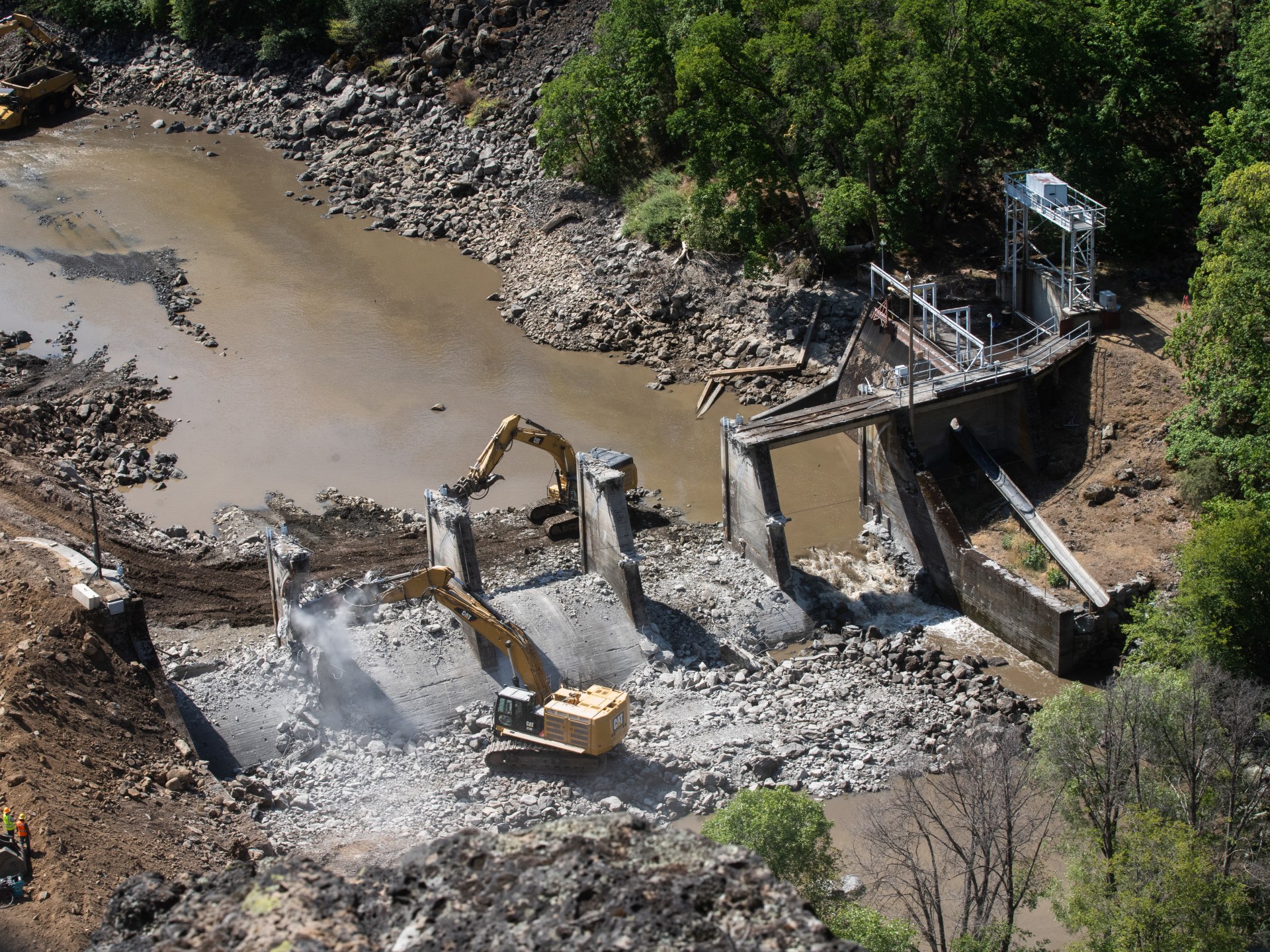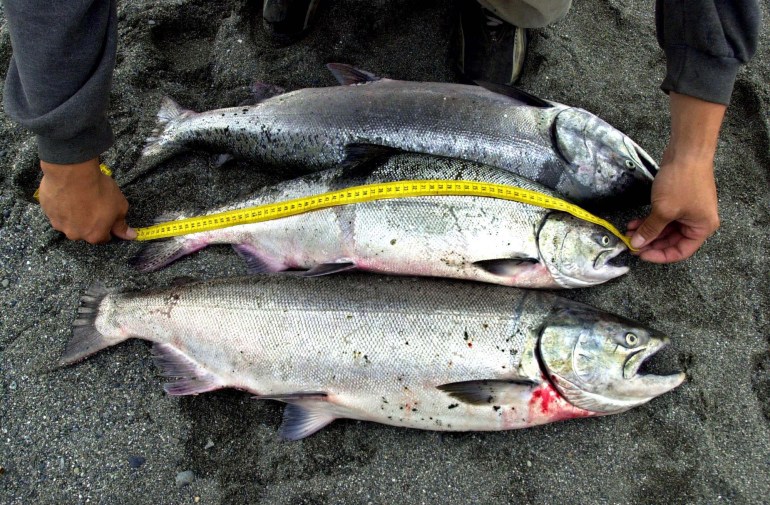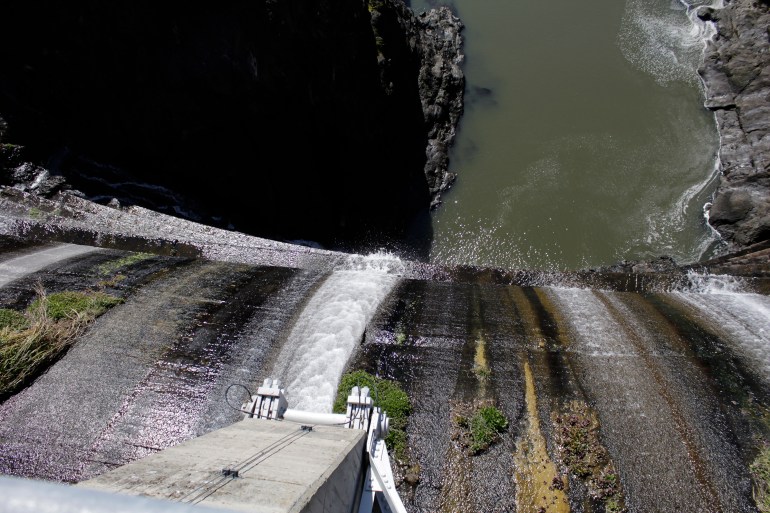
Every fall, Barry McCovey, a Yurok Tribe member and tribal fisheries director, takes his four children salmon fishing on the Klamath River, California’s second largest river.
A strong salmon catch typically brings his family 30 or 40 fish. The supply is large enough to last all year round: you freeze the salmon, smoke it and serve it either on its own or on sandwiches and crackers.
But this year, predicted salmon numbers were the second lowest since detailed records began in 1978, and the fall fishing season was canceled.
The river’s salmon population has declined due to countless factors, but it is believed to be the biggest culprit Series of dams Built along the river from 1918 to 1962 and cutting off the fish migration routes.
Now, after decades of Indigenous advocacy, four of the structures will be demolished as part of the largest dam removal project in United States history. In November, crews completed the removal of the first of four dams to restore 644 kilometers (400 miles) of fish habitat.
“Removing the dam is the single largest step we can take to restore the Klamath River ecosystem,” McCovey told Al Jazeera. “We will see benefits for the ecosystem and therefore for the fishery in the coming decades.”
The extinction that sparked a change
The decades-long battle to remove the dam began with a devastating fish kill.
For thousands of years, the Klamath River has been a cornerstone of Yurok culture, providing its residents with an abundance of Chinook salmon, coho salmon and steelhead trout.
But starting in the 20th century, dams interrupted the flow of the river and collected the water in reservoirs to be used for hydroelectric power and agricultural irrigation.
However, McCovey says reservoirs can cause water to stagnate, warm and lose oxygen. These conditions, in turn, worsen water quality and increase the spread of fish-killing parasites.
This threat escalated into a crisis in 2002. Drought had hit the region and farmers were pushing for more water for crops like potatoes and alfalfa. Some even wore ribbons and pins and condemned the water restrictions as a form of “rural genocide” that threatened farmers’ livelihoods.
Given the pressure, the U.S. Bureau of Reclamation diverted more water from the dams to agriculture. However, this decision resulted in river levels remaining low. Soon, adult salmon washed up dead, their gills brown with dead tissue and mottled with parasitic infections.
Critics estimate that up to 70,000 salmon died because disease spread through the population.
It was a turning point. The fish kill in 2002 prompted tribes like the Yurok to take action to protect the river ecosystem and their way of life.

A “turning point”
Four years later, in 2006, the license for the hydroelectric power plants has expired. This presented an opportunity, according to Mark Bransom, CEO of the Klamath River Renewal Corporation (KRRC), a nonprofit organization formed to oversee the dismantling of the dam.
standards to protect fisheries elevated Since the original license was granted, the utility responsible for the dams was faced with a choice. The company could either upgrade the dams at an economic loss or enter into a settlement agreement that would allow it to operate the dams until they could be demolished.
“A big factor was economics – knowing that these facilities would need to be rebuilt to bring them up to modern environmental standards,” Bransom explained. “And the economic situation just didn’t cut it.”
The utility company chose the settlement. In 2016, the KRRC was formed to work with the state governments of California and Oregon to remove the dams.
Final approval because the deal came about in 2022, which Bransom calls a “turning point.”
Regulators at the Federal Energy Regulatory Commission (FERC) voted unanimously to remove the dams, citing benefits to the environment and tribal tribes.
“I don’t think the Commission necessarily spent a lot of time thinking about the impact of our decisions on tribes several years ago,” FERC Chairman Richard Glick said in a statement public meeting to announce the decision. “I think we are making progress on that front. There’s still a long way to go, but we’re making the right progress there.”
For Bransom, the chairman’s words were a “real revelation,” an acknowledgment the likes of which he had never heard from the commission.
“This was the first time this agency of the U.S. government has made such comments,” Bransom said.

Fighting against a “core American value”
Amy Cordalis, a member of the Yurok tribe, fisherman and the tribe’s attorney, attributes the “colonial mindset and racism” to earlier preventing the dam’s demolition.
“Nobody believed in removing the dam,” she explained. It contradicted the ideals many Americans had been raised with: that humanity was destined to tame the natural world.
“We have fought this core American value that nature exists to serve people at all costs,” she said. “That was the biggest thing for us. It wasn’t about people, money or laws. It was that attitude.”
For Cordalis, the Klamath River is more than a waterway: It is a relative with a spirit of its own. In 2019, she helped push the Yurok government to grant legal status to the Klamath, a designation that allows tribal members to seek redress through the justice system if the river is damaged.
Around 2018, Cordalis also became a member of the KRRC board – but her family’s fight for water rights goes way back. She said her relatives had long fought the pressure that would drive them from the river.
Her great-grandmother, for example, was placed in an indigenous boarding school – a residential system designed to eradicate indigenous cultures and force children to integrate into white society. However, she resisted this pressure and eventually returned to her community.
Then there’s Cordalis’ great-uncle Aawok Raymond Mattz, who was arrested under California state law in 1969 for illegal fishing. He took his fight to the Supreme Court and successfully argued that the state had violated the tribe’s fishing rights.
“We’ve been there since the beginning of time, fishing for the same salmon stocks,” Cordalis said. “For us, our cultural lifestyle and everything we do revolves around being a fishing people.”

tears of joy
Destruction of the first dam – the smallest, known as Copco 2 – began in June, with heavy machinery such as excavators tearing down the concrete walls.
Cordalis was present at the start of the destruction. Bransom had invited her and other KRRC board members to visit the bend in the Klamath River where Copco 2 was being removed. She remembers taking his hand as they walked across a gravel ridge toward the water, a vein of blue amid rolling hills.
“And then there it was,” Cordalis said. “Or it wasn’t there. The dam was gone.”
For the first time in a century, water flowed freely through this area of the river. Cordalis felt like she saw her homeland restored.
Tears of joy began to roll down her cheeks. “I cried so much because it was so beautiful.”
For Bransom, the experience was also “profound.” “It really was a rush of energy that literally flowed through us,” he said, calling the visit “perhaps one of the most touching and moving moments of my entire life.”
Demolition of Copco 2 was completed in November and work began on the other three dams. The entire project is scheduled to be completed by the end of 2024.

A return to family fishing
But experts like McCovey say major hurdles remain to restoring the river’s historic salmon population.
Climate change is warming the water. Wildfires and flash floods litter the river with debris. And tiny particles from rubber tires on vehicles are washed from roads into waterways, where their chemicals can kill fish within hours.
But McCovey is optimistic that removing the dam will help make the river more resilient.
“Removing the dam is one of the best things we can do to prepare the Klamath Basin for climate change,” McCovey said. He added that the river’s uninterrupted flow will also help flush out sediment and improve water quality.
The clearance project is not the solution to all of the river’s problems, but McCovey believes it is a start – a step toward rebuilding the interconnected relationship between the waterway and the Indigenous peoples who rely on it.
“We do a little bit of work, and then we start seeing more salmon, and then maybe we can eat more salmon, and that helps our people heal a little bit,” McCovey said. “And once we start healing, we’re at a point where we can start helping the ecosystem a little bit more.”
McCovey is looking forward to the spring salmon run – and the opportunity to return to his family’s fishing traditions with his children.
“My hope is that next year we can see better fishing and then we can go fishing and hopefully catch the fish we need.”






Recent Comments